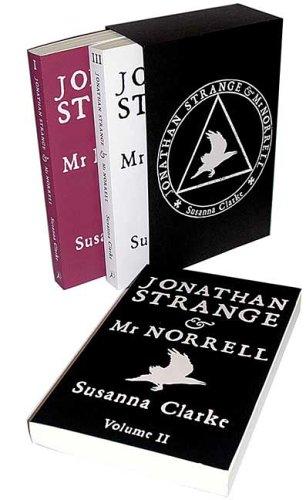Review of "Jonathan Strange & Mr. Norrell Boxed Three Volume Collector's Edition" on 'Goodreads'
5 stars
Susanna Clarke’s first novel is an extraordinarily imaginative tale about two magicians during the early 1800s, in which magic and fairies are not merely trickery and sleight-of-hand, but real enough to jump out of the pages. There are a multitude of characters in this novel, and they are all described in lavish detail. Some have Dickensian names, too.
This is a large book--782 pages, which includes lots and lots of tiny footnotes, which function as both asides and background. On some pages, the footnotes actually take over the page, and are some of the most ingenious parts of the book.
We meet Mr. Norrell first. He is a rich, scholarly recluse who lives to read magic books. In fact, he’s intentionally bought up all the available magic books for the purpose of preventing anyone else from studying magic. Norrell is the epitome of self-centered and egotistical, and decides that he is the man to bring magic, long absent, back to England.
Now that I’ve introduced this--man, I’ll skip up to p. 82, and tell you about the event that puts all the events in motion: in order to gain attention and adoration, especially from the English government, Norrell uses what he calls black magic to summon a fairy to help him bring back to life the recently-deceased Lady Pole, the wife of a government minister. However, this fairy, who we only ever know as “the gentleman with the thistledown hair,” is just as mean and egotistical as Mr. Norrell, and so demands something in return: for restoring the life of the young Lady Pole, he lays claim to half of her life, and Mr. Norrell agrees to this, because he doesn’t really care about the young lady, and it never occurs to him that he has no right to play God.
Not much later, Norrell discovers that the gentleman with the thistledown hair interpreted “half of her life” as “every evening.” In other words, she’s under an enchantment, and basically his slave. Lady Pole’s life becomes a misery, and people assume that she is mad. Eventually, the gentleman with the thistledown hair victimizes two other people, as well.
Bringing a young woman back from the dead certainly earned Mr. Norrell his fame, as well as the attention of the government. Soon, the government ministers found him meaningful employment, such as casting spells to protect England’s shores from her enemies.
Almost two hundred pages go by before we meet Jonathan Strange, who is a very different kind of man, and much younger. Strange eventually becomes Norrell’s pupil, much to many people’s surprise. However, Norrell is still stingy and secretive; Strange never does have the full run of the old man’s library (until the very end), and is, at first, kept in the dark about much of magical history.
Mr. Norrell uses his notoriety and his pupil to advance the notion, (in a periodical publication), that English magicians ought not to have anything to do with fairies--that fairies were dangerous, crazy, and evil, and magicians who used them as servants were being lazy, since it was totally unnecessary. He especially villifies John Usglass, better known as The Raven King, the king of all fairies.
Of course, the reader knows about Norrell’s hypocrisy all along. Jonathan Strange eventually quarrels with Norrell over the idea that they should be presenting to the public a more balanced view of magical history , and not just Norrell’s opinions. Strange publishes his view that there would be no magic if there were no John Usglass, and the two magicians part ways.
Meanwhile, the gentleman with the thistledown hair has his own plans....including taking Arabella Strange (Jonathan's wife) as another of his slaves, and setting up the English Butler Stephen Black as King of England (against his will. He's unhappily enchanted, too).
Will these three victims escape their enchantment? Will Mr. Norrell ever have to face the music for what he did to Lady Pole? What about the gentleman with the thisledown hair? Will The Raven King return and set all to rights?
Oh, and there's another big problem, but I will stop writing about the book's plot, now.
I was gently drawn into this novel--it wasn't exactly an urgent read, but it was--enchanting. Susanna Clarke does a wonderful job imagining Jonathan Strange’s relationships with real people, such as Lord Byron and the Duke of Wellington. My only fault with the book was that the section about Strange’s service to Duke Wellington during England’s war against France dragged a bit.
And the end? The end is WIDE open--I believe there is to be a sequel.

